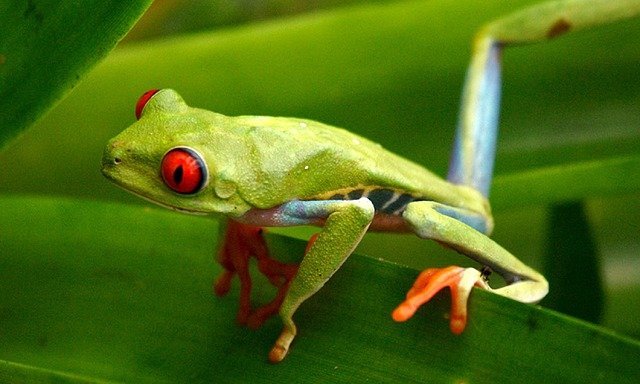The red-eyed tree frog is one of the most recognizable tree frogs in the world, with distinct green and yellow coloring and bulging red eyes. Despite how cute they look, some predators actually choose to eat them. So, what eats a red-eyed tree frog?
- Snakes
- Spiders
- Bats
- Owls, and…
- Toucans
Basically, anything that can sneak up or swoop down on the red-eyed tree frog as it makes its home in the trees.
Natural Predators of The Red-Eyed Tree Frog
Snakes
Snakes eat red-eyed tree frogs as well as their eggs. They use the element of surprise to sneak up behind the frogs and bite them. A snake can swallow a frog whole and begin to digest it without even chewing.
Snakes also like to eat the eggs of red-eyed tree frogs. Typically the mother tree frog lays her eggs so they hang on the underside of leaves above pools of water. It takes just four to five days for the eggs to hatch and for tadpoles to fall into the water.
Snakes during these four to five-day windows have the chance to gobble up a good source of nutrition. In fact, the eggs can force themselves to hatch early, even before they are ready. This prevents them from being eaten before they have a chance to fall into the water.
Spiders
Believe it or not, giant spiders enjoy munching on red-eyed tree frogs too. Tarantulas the size of dinner plates have been seen in the wild eating nearly everything. Even animals as large as mice.
These large spiders, like snakes, use stealth tactics to sneak up on the frogs. Once close enough, they pounce, biting the frog and injecting a lethal venom into it. Even without the venom, a tarantula has an extremely powerful bite for its size, enough to crush the skull of a tree frog.
Bats
Bats are also natural predators of red-eyed tree frogs. The fringe-lipped bat preys on frogs by listening for their vocal calls. They can also locate tree frogs from the noise made as the frog makes contact with water. Bats will be more likely to attack if both sounds are heard at once.
At dawn, just as the sun is starting to come up, bats set out to catch frogs. As red-eyed tree frogs are nocturnal, their eyesight is better suited to night time. As bats rely on echolocation, they do not need darkness to find prey, they, therefore, find it easier to catch frogs at this time.
Owls
Owls are nocturnal too. However, they rely on eyesight rather than echolocation. Owls have large eyes with slits that open up wide, allowing them to see more in low lighting. Their heads
can rotate 270 degrees which allows them to look in all directions while maintaining camouflage.
The Central American pygmy owl preys on red-eyed tree frogs that live in countries such as Guatemala and Panama. Their small size at just fifteen centimeters allows them to sneakily swoop down and pick up tree frogs and carry them away, holding them with sharp talons.
Toucans
That’s right, toucans eat frogs. Although their diet mostly consists of fruit, toucans have been known to occasionally eat frogs and insects. The sides of their beaks are jagged and sharp and can easily penetrate the skin of a red-eyed tree frog.
Toucans in captivity have been observed to survive on a carnivorous diet exclusively. Given the option, they will choose fruit over prey but are known to supplement their diet occasionally with some sources of protein in the form of frogs, small rodents, or insects.
Honorable mentions…
Although red-eyed tree frogs are native to Central America, many people now keep them as pets. They live in containers known as vivariums in which temperature and humidity can be regulated.
If your dog or cat manages to get into the vivarium and decides your frog looks like a tasty snack, it is important to take them to the vet.
The skin of red-eyed tree frogs contains a toxin that can upset the dog or cat’s stomach, or if they are small or vulnerable enough, may kill. unlike the other predators listed, dogs and cats have not developed immunity to the toxin.
In order to stop this from happening, make sure your vivarium is tightly sealed and won’t be knocked over. You may want to consider also keeping your dog or cat away from the vivarium entirely.
Even Before They are Frogs…
If there weren’t enough different predators for red eyed tree frogs already, they are even preyed upon before they are fully grown.
Before they are fully formed frogs, tadpoles of red-eyed tree frogs are eaten by:
- Dragonflies
- Fish
- Water beetles
The tadpoles are especially vulnerable as their only form of defense is their ability to be fast swimmers. Once hatched into the water the tadpoles are left to fend for themselves, and therefore they can be easily preyed upon by other inhabitants of the water.
The takeaway
Tree frogs in the wild are eaten by many different predators. Their only form of defense is their toxic skin, their speed and agility, and their brightly colored skin.
In the wild, brightly colored skin is used as a signal that the animal is toxic. Some predators will avoid brightly colored reptiles and amphibians for this reason alone.
To have a look at our Red-Eyed Tree Frog Guide Click on the image below.





